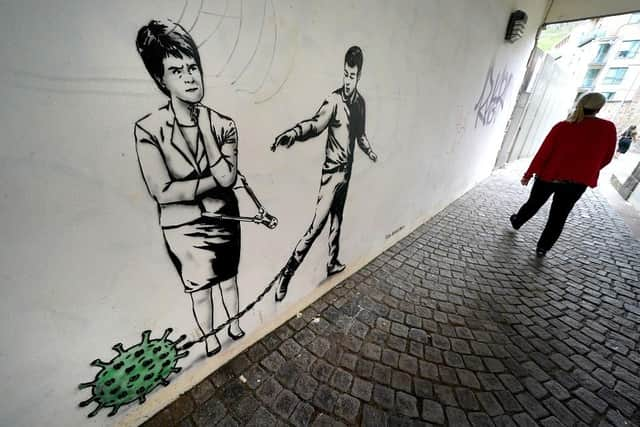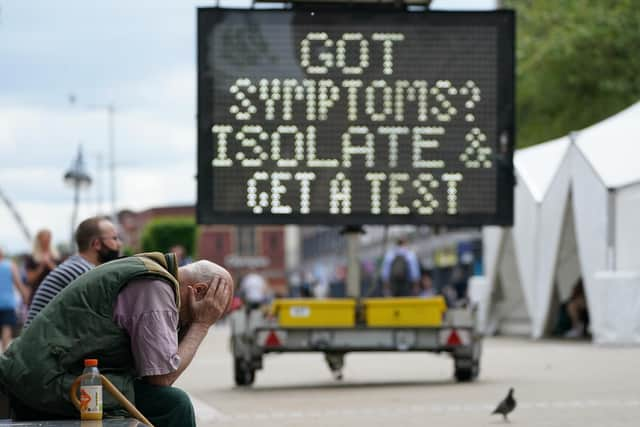Covid Scotland: Scottish ministers told to prepare for 400 Covid deaths a day ahead of second wave
Following disclosure of a paper compiled by the Scottish Government from August 20, 2020, the data with which Nicola Sturgeon made policy decisions about the rights and freedoms of Scots can now be published.
The publication of the Covid-19 deaths modelling comes after the Scottish Information Commissioner ruled ministers had breached Freedom of Information legislation by withholding the data.
Advertisement
Hide AdAdvertisement
Hide AdThat was the result of a nearly year-and-a-half transparency battle with The Scotsman, with commissioner Daren Fitzhenry stating that in “all the circumstances” of the case, the public interest lay in favour of making the information public.


Opposition politicians criticised the Scottish Government for keeping the predictions secret for so long, and said the predictions seemed to have been “overly pessimistic”.
The paper presented three scenarios and gave death estimates, none of which were made public at the time.
They included:
An autumn peak with around 30 deaths a day and a total of up to 1,500 deaths; A winter peak after a “continuous drop” in the number of Scots infected with Covid-19, causing between 70 to 80 deaths a day and a total of between 7,000 to 8,000 deaths overall, rising to 12,000 when including worst-case causes of increased winter mortality; A winter peak after a small autumn resurgence, causing 220 to 270 deaths a day, and a total of 17,000 to 20,000 deaths overall, rising to 400 deaths a day and 26,000 deaths in total on a worst-case scenario basis for other causes of winter mortality.


The paper warns the most likely cause of a second peak of Covid-19 infection was due to the increase in social mixing as restrictions from the first lockdown and summer were slowly lifted.
It adds the potential death figures would be “significantly worse than anything described in this paper as a ‘worst-case scenario’”.
The paper states the modelling was based on two times at which “it would be particularly bad for a resurgence to happen”, warning that an autumn peak would be when Test and Protect was unable to provide an early warning alongside “significant” numbers of Covid patients in hospital.
The winter peaks, by contrast, were worrying due to a “surge” in illnesses such as influenza and when immune systems are “at their weakest to deal with Covid”.
Advertisement
Hide AdAdvertisement
Hide AdHowever, the paper warned the predictions of a bad flu season could be considered “pessimistic” due to social distancing measures still being in place.
On the date of the report, Nicola Sturgeon told Holyrood Scotland would remain in phase three of its lockdown restrictions, requiring offices to stay closed alongside a ban on indoor live events, the continued closure of indoor sports courts and indoor entertainment venues.
At the time, restrictions on indoor gatherings was limited to eight people from three households, with a wide variety of measures placed on hospitality.
The First Minister warned MSPs: “If we opened everything up right now, the overall impact would simply be too great. The virus would run away from us and we would, in all likelihood, be forced to reintroduce restrictions that none of us wants to see.”
Shortly after the modelling was handed to ministers, the Scottish Government worked with product specialists to ensure a stock of at least 1,000 body bags were available to funeral directors in Scotland ahead of the then-potential second wave.
Other predictions, which The Scotsman can reveal was submitted to ministers a week earlier than the date of the report disclosed, set out a potential peak need of 700 ICU beds and 5,000 acute beds, alongside 400 deaths a day.
Official data states the second wave – caused predominately by the Alpha variant in December, but also sparked by a small peak in October following the return of students to universities – killed almost 5,200 people.
As of February 25, 2022, Scotland has suffered 10,656 deaths from Covid.
Advertisement
Hide AdAdvertisement
Hide AdScottish Conservative health spokesperson Sandesh Gulhane said modelling had been “crucial” to helping governments during the pandemic, but said the details should have been made public.
He said: “From looking at the SNP Government’s modelling, it could be argued that the worst-case assumptions proved overly pessimistic.
“But regardless of that, in the interests of transparency and ensuring public support for the measures imposed, the SNP Government ought to have made these projections public.”
Scottish Liberal Democrat leader Alex Cole-Hamilton attacked the Scottish Government for a lack of transparency and said earlier publication of the report could have helped to “understand and justify” Covid restrictions.
He said: "Yet again it has taken persistent work from the press to force the Scottish Government to reveal its secret modelling of the scale of threat posed by the Covid pandemic.
"It's not clear why ministers and officials are so determined to keep these predictions under lock and key. Allowing health experts and the public to scrutinise this modelling could have helped to understand and justify the extraordinary restrictions on life and liberty that we have all lived with over the past two years.
"Fortunately the worse-case scenario envisioned in these papers did not come to pass. Now that they are finally public, I hope that this will enable proper scrutiny about the assumptions that the Government made and whether they were accurate."
Scottish Labour’s depute leader, Jackie Baillie, said “transparency and openness” should have been central to the government’s response to Covid-19.
Advertisement
Hide AdAdvertisement
Hide AdShe said: “The government’s modelling must be subject to scrutiny so we can make sure it’s as accurate as possible – but it’s hard to do when they are hiding it from the public.
“The culture of secrecy at the heart of the SNP is not just a transparency issue but a public health liability.”
A Scottish Government spokesperson said it publishes a weekly modelling report, including a projection of infections, hospital occupancy and deaths.
They said: “These results indicate the current trends in the epidemic, based on the best available modelling. The future around SARS-CoV-2 is uncertain and therefore there are a number of possible Covid-19 futures that may occur.
"One approach to this uncertainty is to model alternative versions of the future through the development of different Covid-19 scenarios.
“We draw upon the best available evidence and analysis, including scientific advice and modelling, to develop planning scenarios against which to assess our collective preparedness.
"Throughout the pandemic modelling has been part of the information set that informs decisions, alongside surveillance data, intelligence from health boards and surveys that improve our understanding of behaviours.”
Want to hear more from The Scotsman's politics team? Check out the latest episode of our political podcast, The Steamie.
It's available wherever you get your podcasts, including Apple Podcasts and Spotify.
A message from the Editor:
Thank you for reading this article. We're more reliant on your support than ever as the shift in consumer habits brought about by coronavirus impacts our advertisers.
If you haven't already, please consider supporting our trusted, fact-checked journalism by taking out a digital subscription.
Comments
Want to join the conversation? Please or to comment on this article.
